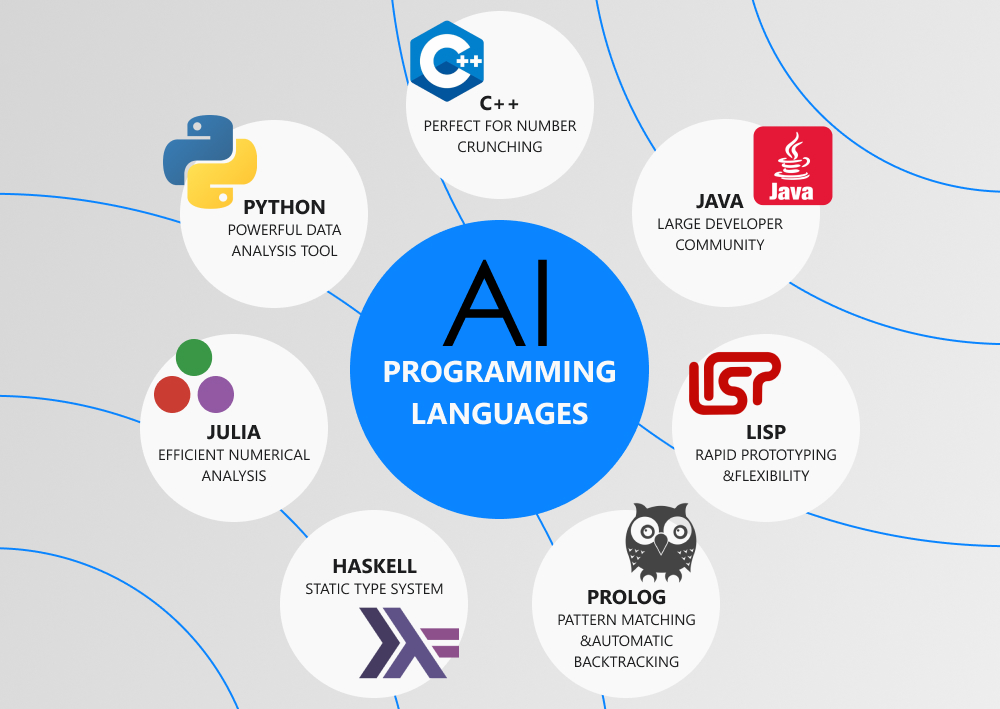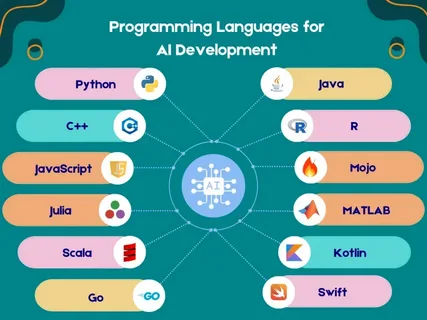The top AI programming languages in 2025, their strengths, and why they are essential for building cutting-edge artificial intelligence solutions.
Introduction
Artificial Intelligence (AI) has transformed industries across the globe, from healthcare and finance to e-commerce and entertainment. At the core of this transformation are AI programming languages—the tools developers use to build intelligent applications. Choosing the right language can significantly impact performance, scalability, and innovation in AI projects.
In this article, we’ll explore the top AI programming languages in 2025, their unique strengths, and how they are applied in real-world AI development. Whether you’re a beginner exploring AI or a seasoned developer, understanding these languages will help you stay ahead in the rapidly evolving AI landscape.
Why Programming Languages Matter in AI
The right programming language:
- Boosts efficiency by providing pre-built AI libraries and frameworks.
- Enhances performance in tasks such as natural language processing, deep learning, and computer vision.
- Simplifies scalability for enterprise-level AI projects.
- Supports community growth, ensuring continuous updates and resources.

Top AI Programming Languages
1. Python – The King of AI Development
Python has dominated AI development for years, and in 2025, it remains the most popular AI programming language. Its simplicity, readability, and vast ecosystem make it the go-to choice for both beginners and professionals.
Key Features:
- Extensive AI and machine learning libraries such as TensorFlow, PyTorch, Scikit-learn, and Keras.
- Excellent support for data manipulation with Pandas and NumPy.
- Strong community and continuous innovation.
Use Cases:
- Deep learning and neural networks.
- Natural language processing (NLP).
- AI chatbots and virtual assistants.
- Computer vision and robotics.
Example: Google’s TensorFlow is primarily Python-based, enabling developers to build advanced deep learning models with ease.
2. R – The Language for Data-Driven AI
R is widely recognized for statistical computing and data visualization, making it highly effective in AI research and predictive analytics. While not as beginner-friendly as Python, it is invaluable for data scientists working with complex datasets.
Key Features:
- Rich libraries such as caret, randomForest, and nnet.
- Powerful data visualization tools like ggplot2.
- Excellent for mathematical modeling and statistical analysis.
Use Cases:
- Predictive analytics in finance and healthcare.
- Machine learning research and data mining.
- Bioinformatics and pharmaceutical studies.
3. Java – Reliable and Scalable AI
Java continues to hold a strong position in AI, particularly in enterprise environments. Its scalability, portability, and security features make it ideal for building AI-driven applications that require robustness.
Key Features:
- Frameworks like Deeplearning4j and MOA (Massive Online Analysis).
- Platform independence using the Java Virtual Machine (JVM).
- Excellent integration with enterprise-level systems.
Use Cases:
- Fraud detection in banking.
- Large-scale recommendation systems.
- AI-powered web and mobile applications.
4. Julia – The Rising Star in AI
Julia is a high-performance programming language that has gained traction in AI due to its speed and mathematical efficiency. It combines the ease of Python with the speed of C, making it particularly useful for computationally heavy AI tasks.
Key Features:
- Exceptional performance for numerical computing.
- Libraries like Flux.jl for machine learning.
- Easy integration with Python and C.
Use Cases:
- Scientific AI research.
- Real-time data analysis.
- High-performance computing in AI simulations.
5. C++ – Powering AI at the Core
While not as beginner-friendly, C++ remains essential in AI development where performance and efficiency are critical. It is widely used in building AI engines and resource-intensive applications.
Key Features:
- High execution speed and memory management.
- Used in AI game development and robotics.
- Integration with machine learning libraries.
Use Cases:
- Real-time AI systems in robotics.
- AI-driven gaming engines.
- High-performance AI simulations.
6. JavaScript – AI for the Web
JavaScript may not be the first language that comes to mind for AI, but its role in web-based AI applications has grown significantly. With the rise of libraries like TensorFlow.js, developers can run AI models directly in browsers.
Key Features:
- Enables client-side AI deployment.
- Easy integration with web apps.
- Large developer community.
Use Cases:
- AI chatbots for e-commerce websites.
- Browser-based machine learning applications.
- Real-time sentiment analysis on social media platforms.
7. Lisp – The Classic AI Language
Lisp is one of the oldest AI programming languages, known for its symbolic processing and rapid prototyping abilities. While less popular today, it remains influential in AI research.
Key Features:
- Unique features for symbolic AI.
- Excellent for developing rule-based AI systems.
- Historical significance in AI’s evolution.
Use Cases:
- AI research projects.
- Prototyping intelligent systems.
- Expert systems in academia.
Comparing the Top AI Languages
| Language | Strengths | Best For |
|---|---|---|
| Python | Easy to learn, vast AI libraries | Deep learning, NLP, computer vision |
| R | Strong in statistics and data analysis | Predictive modeling, data science |
| Java | Scalable, secure, enterprise-ready | Large-scale AI applications |
| Julia | High-performance computing | AI research and simulations |
| C++ | Speed and efficiency | Robotics, real-time AI |
| JavaScript | Web-based AI | Browser AI, chatbots |
| Lisp | Symbolic processing | AI research and prototyping |

Future Trends in AI Programming
- Hybrid Language Models: Developers may increasingly combine Python with C++ or Julia for performance boosts.
- AI for Web and Mobile: JavaScript and Swift are gaining traction in bringing AI to end-users.
- Quantum Computing and AI: Emerging languages tailored for quantum AI may shape the next decade.
Conclusion
The top AI programming languages each bring unique strengths to the table. Python continues to dominate due to its ease of use and extensive libraries, while languages like R, Julia, and C++ serve specialized AI needs. For enterprise projects, Java remains a reliable choice, and JavaScript is expanding AI’s reach to the web.
If you’re starting your journey in AI, Python is the best entry point. For professionals, mastering multiple languages will give you a competitive edge in developing versatile and powerful AI solutions.
👉 Ready to explore more? Check out our guides on how to learn machine learning online, best AI tools for business, and how to build a chatbot with AI.
External Sources for Reference:

17nhgs